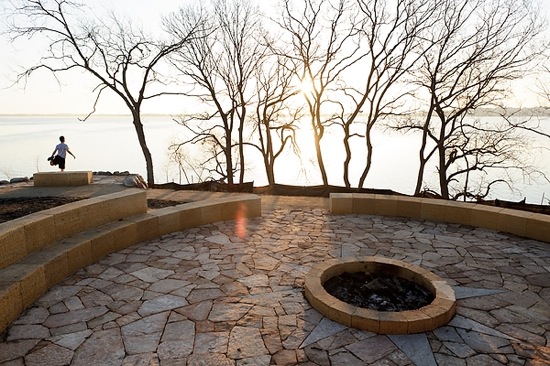Picnic Point: Nicer than ever

At dawn, a runner stops to stretch and take in the sunrise view of the Lake Mendota from a newly constructed, stone gathering circle and fire pit at the tip of Picnic Point. In addition to the installation of broad stone steps that now lead visitors to the shoreline, staff and volunteers also cleared the tree-lined area of invasive buckthorn shrub. Picnic Point is part of UW–Madison’s Lakeshore Nature Preserve.
Photo: Jeff Miller
It’s always been a favorite spot on the University of Wisconsin–Madison campus, but Picnic Point had been showing its wear.
Invasive trees and shrubs have blocked views and turned paths into tunnels worthy of a gothic horror tale. Tourists have trampled, and students have stumbled. The results were evident, especially at the tip of the point, surrounded on three-and-a-half sides by Lake Mendota.
Now, through the generosity of the Ebling Picnic Point fund, this sacred area is on the rebound.
The improvements start at the point itself, where landscape architects and contractors have just finished building a stone gathering circle around a firepit. Nearby, a set of winding stone steps give access to a small platform just above the lake.
For the first time, visitors at the point can safely walk down to the water, without eroding the fragile banks, says project manager Rhonda James, a landscape architect with Facilities Planning and Management.
“We’ve created a more durable surface so the land will not be destroyed by popularity, and made the gathering circle accessible,” says James. “Everybody, naturally, wants to get down to the water, and we’ve installed large, broad stone steps to make that easy, and also removed some weedy trees to open the view. I think these are changes that Picnic Point has been needing for many years.”
At the tip of the point, and throughout the preserve, FP&M staff, members of the Friends of the Lakeshore Nature Preserve, and a host of volunteers, are removing buckthorn, a dense, invasive shrub that blocks views, shades the ground, and dominates other plants.
The removal takes a lot of work, James says. “It’s hand-to-hand combat, and we need to find a long-term plan to care for the area once the removals are done.”
“The Ebling family wanted to honor their mother, Elsie Iwen Ebling, by improving Picnic Point, which embodies the natural world that she loved,” explains Bill Barker, head of the Lakeshore Nature Preserve Committee. “We had a good public process last year, with lots of input and meetings, and arrived at consensus design that satisfied the donor, the campus community, and the public. Thousands of people go out to Picnic Point each week, but it did not have the engineering to handle that level of traffic; it was severely degraded, badly eroded.”
The upgrades “provide a nice gathering space for the campus community, and a safe, easy way to reach the water,” Barker says. “We wanted to remove invasive plants and establish a healthy native community by planting native shrubs and grasses. And we wanted to open the view so you could see the lake, the campus, the capitol.”
Any change at the point, one of the most revered spots on campus, must be done delicately, Barker acknowledges. “This lakeshore is a sacred area, and probably has been for thousands of years. I don’t think the Native Americans constructed mounds lightly, and there are several mounds on that strip of land. We are trying to respect those traditions, and be good stewards for future generations.”
The UW–Madison campus is a natural place to honor and repair nature, Barker says.
“Think about how the people who came from this campus shaped our view of the environment. John Muir, founder of the Sierra Club, was the first to say that nature is beautiful and worth saving for its own sake, a radical idea for the mid-nineteenth century. And then Aldo Leopold, our first professor of wildlife ecology, wrote about the ‘land ethic,’ and our obligation to care for the land and its living inhabitants,” he says.
Barker adds: “The fact that this campus has chosen to honor that legacy by devoting one-third of its acreage to a nature preserve shows an unbelievable generosity of spirit. And the Ebling Family Trust, with this donation, has helped ensure that this treasured land will be even more valuable, and more beautiful, as the years go by.”




